Nagorno-Karabakh / the Caucasus
Limbo land
The republic of Nagorno-Karabakh in the Caucasus lies in purgatory. Despite its violent history, peace and PR is seen as the fastest route to normality; we visited just before the most recent flare-up to see if it can succeed.
Nagorno-Karabakh is a fissure in the heart of the Caucasus that threatens to escalate into full-scale war. It’s also a tiny unrecognised republic trying to etch out an economy, trumpet its democracy and launch its own brand of caviar.
On the streets of Stepanakert, the capital, Karabakh’s six-year conflict with Azerbaijan – which officially ended in 1994 – is never far from citizens’ minds. Soldiers in camo-coloured huts talk and nod to unfamiliar faces; shepherds herd their flocks past tank formations; veterans drive taxis in their old army jackets. Even the new caviar factory is staffed by men in woodland-print fatigues, guarding vats of Siberian sturgeon.
Though the war has been frozen for two decades, it occasionally catches fire. The worst violence since the ceasefire broke out in April, with reports of land snatches and extensive casualties in both Karabakh and Azerbaijan. The roots of the dispute are murky. This enclave of Armenians and Azeris felt its share of interethnic strife for centuries. But when it was absorbed into the Soviet Union, Karabakh was made an autonomous region within Soviet Azerbaijan and communist rule slammed a lid on the squabble. This remained the status quo until 1988 when, with perestroika in the air, Karabakh’s Armenian majority agitated to join the coming Republic of Armenia. Growing tensions unravelled into civil war that saw massacres, pogroms and whole villages emptied of people.
Karabakh declared itself a republic in 1991 and a ceasefire was brokered by Russia in 1994. Some 25 years after its independence, the republic is not recognised by a single nation state – even by Armenia, which outwardly keeps a diplomatic distance from the conflict.
Like many of the top brass in Stepanakert, president Bako Sahakyan fought in the war and doesn’t mince his words. “This is not a conflict between Armenian people and Azerbaijani people: it is a struggle against atrocities and genocides,” he says. “If we didn’t defend our motherland then there would be another genocide here.”
Sahakyan, who has little more than a year left in office, smokes several thin cigarettes while his spokesperson translates; in the presidential office, the lights are on and the curtains drawn. “The most important characteristic of our armed forces is that it’s a people’s army,” he says, referring to the original volunteer force in the war. “The Defence Army is the main guarantor of our security and independence.”
The ferocity of April’s escalation was unexpected but the violence surprised no one. A peace process mediated by the US, France and Russia – a troika called the Minsk Group and organised under the Organization for Security and Co-operation in Europe (OSCE) – had slowed to a bitter stalemate. Azerbaijan sees no progress on its territorial claims, while both sides say ceasefire violations are getting worse and offenders are not being brought to task. Couple this with an economic plummet in Azerbaijan fuelled by the oil-price slump and a skirmish that can rally both nations was inevitable.
It may be a secretive war but Karabakh is remarkably media savvy in its bid to tell its side of the story. We’re taken to a teal-coloured military base on the outskirts of Stepanakert, past the airport that has never seen an aeroplane take off for fear of it being shot down and over a river of frothing ice melt. Our guide, Gegham Grigoryan, a soldier whose job is to “accompany journalists and defend the motherland”, is vigilant throughout. “No photos here,” he tells us, the first of many times, waving his hand towards a platoon training on the forecourt.
We’re brought before Commander Tevosyan, who barely moves his lips as he speaks. “The situation is tense; 10 days ago they used mortars on us but there were no casualties,” he says. “If they shoot with snipers, we shoot with snipers. If they fire mortars at us…” Tavosian pauses to swivel a computer monitor on his desk. In silence, we watch a grainy aerial video of an Azeri military facility that erupts into bright explosions as tiny figures scramble out of the way. The commander won’t tell us his unit’s name, how many soldiers he manages or what training soldiers receive.
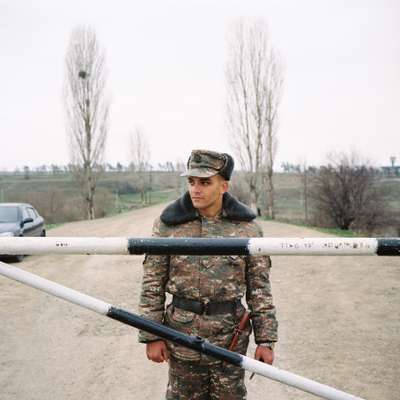

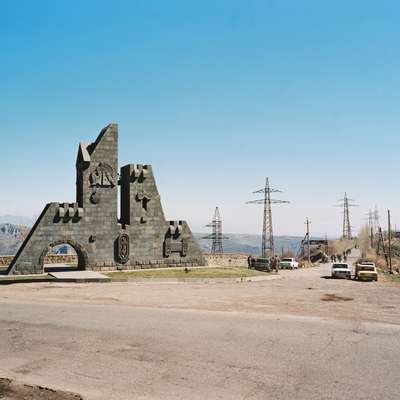
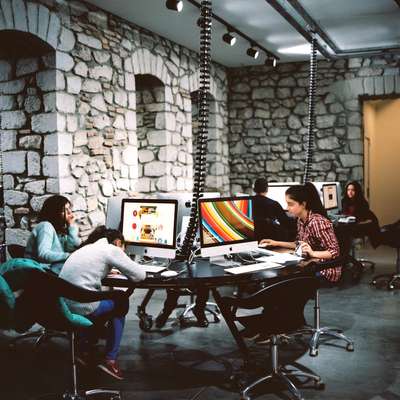

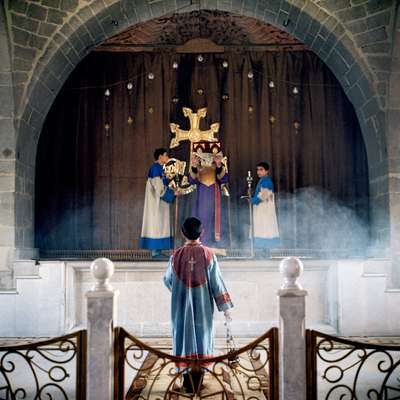

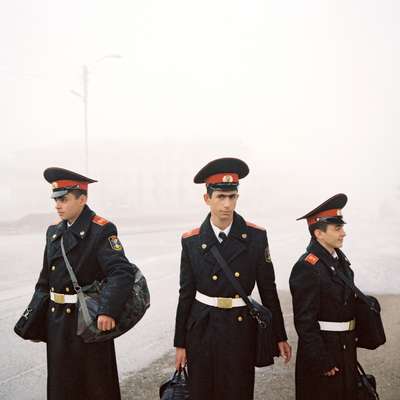


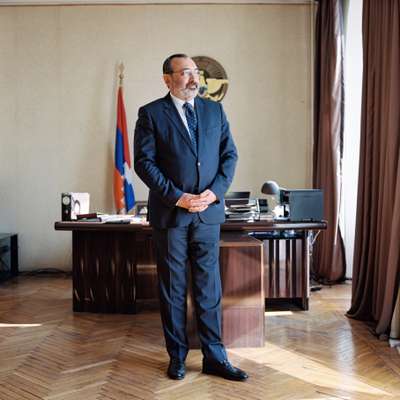
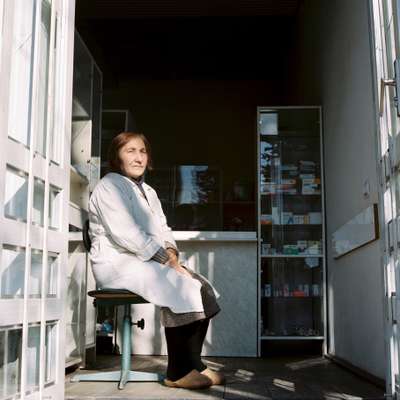
Everyone is on alert, all intelligence scrutinised as potentially useful to the enemy. Outside, Grigoryan admonishes us: “The most important thing here is you don’t ask questions about numbers and don’t ask about periods of time.”
We’re ushered into a Jeep and a squaddie drives us towards the Line of Contact, through the ruins of Agdam. The conflict caused mass displacement: Azerbaijanis fled from Yerevan and Karabakh; Armenians from across Azerbaijan. Estimates vary but some report that Agdam was home to about 150,000 people before most sought refuge in Baku. Yet the six-year war was also punctuated by harrowing atrocities; Armenians commemorate 28 February for Sumgait, a town on the Caspian Sea, where an Azeri nationalist rally sparked a murderous pogrom in 1988. The Azerbaijanis mourn Khojali, a town now held by Karabakh, where it’s alleged that more than 600 civilians were gunned down by militia.
Somewhere in the middle of devastated Agdam, two Armenian soldiers are washing a Lada, while behind them is the only intact structure around: a mosque with a tiled minaret. Stretching far off into the distance are mile after mile of ruined houses, fenced off from the army road by a wall of kitchen stoves.
Eventually ruins give way to skinny cows, then meadows, then barbed wire, and we stop at a trench that’s 400 metres from the Line of Contact. Etched into the bleak hillside and lined with rusty tuna cans for decoration, the trenches snake along the border.
The soldiers manning the front are wary but they whack a pile of biscuits onto a table and brew tea. There was gunfire across the border last night, one young sergeant tells us. Another recruit says that they have recently had to rebuild part of the trench. We’re shown a metal cylinder built into the wall of a guard hut, which a soldier rotates using his gun, revealing a small hole and a glimpse of the muddy haze in no-man’s-land.
Major Robo Aghasaryan has a faded tattoo on his hand dating from his time in the volunteer force; the unit call him “the mayor of the trenches”. Like other civilian forces, the Nagorno-Karabakh Defence Army has acquired mysticism. “During the war, seven people could be full from one piece of bread,” he says. “It’s a waiting situation here but the ceasefire violations started getting worse after January 2015, when oil prices fell.”
On the road back to Stepanakert, no one will say who provides weapons for the Defence Army. Granted, the armaments look aged but the Russian vaz jeep we’re in doesn’t, nor the line of camouflaged trucks heading to the front.
Last year Russia committed a €175m loan to Armenia to modernise its armed forces with Russian-made weaponry. No one in Stepanakert can say they’ve seen any of that money. Yet for observers such as Richard Giragosian, the Armenian-American director of the Regional Studies Center, a think-tank in Yerevan, the entwining of the two armies is a well-known secret. “Armenia doesn’t want to admit this openly because it doesn’t want to be dragged in as a direct party in the conflict,” he says. Meanwhile, Russia’s arms sales to Azerbaijan are common knowledge. If Russia is openly arming both sides of this conflict – and by extension the Nagorno-Karabakh Republic – then it would seem perverse that it’s also a mediator in the conflict.
The Karabakh government is coy about the provenance of its equipment. “It’s not propaganda to say that the most important thing is to have people with modern brains that know why they’re staying on this line,” says Karen Mirzoyan, the minister for foreign affairs. But are the weapons Russian? “We have channels to provide our army with arms,” he says. “But those are not matters to be discussed in such an interview.”
The recent fighting has underscored the inadequacy of the Minsk Group to monitor and mediate in the Karabakh dispute (the representative of the osce chairperson on the conflict declined our request for an interview). “Never have the grounds been clearer for a review of the osce’s mandate,” says Laurence Broers, co-founder and editor of scholarly journal Caucasus Survey. “Clearly the disparity between a force of six unarmed ceasefire monitors – who agree their inspections of a 160-mile [257km] Line of Contact in advance – and the scale of the violence we are seeing is huge.”
In the meantime Minister Mirzoyan is particularly frustrated that the Nagorno-Karabakh Republic has been kept out of negotiations since 1999, when talks became bilateral between Armenia and Azerbaijan. “Believe me,” he says, “it’s not a desire to be recognised and involved in big politics: it’s because we understand the real situation.”
It’s easy to forget here that the representatives of the Nagorno-Karabakh Republic are on the charm offensive. Recognition is still the bottom line. Most understand that peace is the route to normalisation but that would also require truth and reconciliation on both sides. Those we ask evade any concession that atrocities were committed by Armenians during the war for Karabakh.
Peace would anchor this economy. The government says 65 per cent of its economy comes from revenue and taxes, while the rest is loans from Armenia and support from the diaspora. It sees opportunity in its new hydroelectric plant and exports for agriculture and wine, not to mention the potential of tourism – but these ideas only make sense if a ceasefire holds. There are tangible developments too: new neighbourhoods under construction, communication lines being rigged up and once-ruined towns under repair.
The power of the Armenian diaspora can’t be overlooked. Overseas entrepreneurs are bankrolling new businesses while philanthropists and foundations are plugging gaps in education, housing and healthcare. One such scheme is Tumo, a centre for schooling 12 to 18-year-olds in “creative technologies”, from robotics to graphics, film-making to web design. Funded by Armenian-Americans Sam and Sylva Simonian, Tumo launched in Yerevan and has expanded to Stepanakert, with additional funding from the Armenian General Benevolent Union (AGBU).
The centre is managed by Korioun Khatachadourian, a French expatriate who left his job in financial services to come here. “Nagorno-Karabakh is one of the few victories that we’ve had as an Armenian nation,” he says, adding that it’s unfortunate this had to happen by war. “We come in front of the world as victims; sometimes we need victories.”
Go to Yerevan and the spectre of the 20th century is hard to miss, with messages about the genocide on billboards, in museums and on monuments in the streets. Though its memorial is less obvious in Nagorno-Karabakh, it’s there in the Defence Army’s centrality to life in the republic and the motivating idea that someday everything may be lost.
View from Baku
The loss of Nagorno-Karabakh is a wound in Azerbaijan’s psyche. In the 22 years since the ceasefire the country has invested billions in its armed forces and the recent violence in Karabakh was a demonstration of what it can do, while professing self-defence. “This is the first time that Azerbaijanis gained confidence in their own force,” says Anar Valiyev, an associate professor of political science at ADA University in Baku.
Azerbaijan is frustrated at the lack of development regarding its territory claims. Many states, while being diplomatic, maintain its right to pursue territorial integrity; support comes from Turkey, with fiery rhetoric in the wake of recent violence. But the polarisation across Eurasia from Syria to the Caucasus, with Turkey and Nato on one side and Russia and its allies on the other, leaves Karabakh in the middle. Valiyev is nervous: “Show that the frontline between the west and Russia is the Azerbaijan-Armenia border and you can forget Karabakh.”
Facts and figures
Name: Nagorno means “mountainous” in Russian and Karabakh “black garden” in Turko-Persian. It is called Artsakh by Armenians.
Population: 150,932 (estimate, 2015 census)
Capital: Stepanakert (population: 55,000)
Landmass: 4,400 sq km
Declared independence: 1991 (unrecognised by any nation state)
Language: Armenian
Russia’s role
Despite recommendations for peace, Russia continues to sell arms to Armenia and Azerbaijan but the theory that Russia would like to see this dispute continue – scuppering an oil pipeline from Baku to Europe – has lost some punch.
“Russia has no ambitions in Karabakh; it certainly doesn’t want conflict on its border,” says Thomas De Waal, who has written extensively on Karabakh. “If Azeris are to return to their homes and Armenians to feel confident in their security, international peacekeepers are needed. The Russians are the only ones interested in doing that.”


